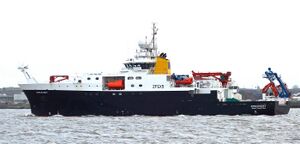Earth:RRS Discovery (2012)

| |
| History | |
|---|---|
| Name: | RRS Discovery |
| Owner: | NERC Research Ship Unit |
| Builder: | C.N.P. Freire, S.A., Spain |
| Cost: | £68 million |
| Laid down: | 16 February 2011 |
| Launched: | 6 April 2012 |
| Completed: | 3 June 2013 |
| Identification: |
|
| Status: | in service |
| General characteristics | |
| Class and type: | Lloyd’s +100A1, Ice 1D, LMC, UMS, DP(AM), IWS, EP, Research Vessel |
| Displacement: | 6,260 tonnes |
| Length: | 99.7 m |
| Beam: | 18 m |
| Draught: | 5.1 – 6.6 m |
| Installed power: | Wärtsilä 8L20 - 4x 1770 kW |
| Propulsion: |
|
| Speed: | 12 knots |
| Crew: |
|
| Notes: | Endurance 50 days |
RRS Discovery is a Royal Research Ship operated by the Natural Environment Research Council. The ship is the third such vessel to be built and named for the ship used by Robert Falcon Scott in his 1901-1904 expedition to the Antarctic.
History
Discovery was built as a replacement for the previous Discovery in the "blue ocean" research role.[1] The ship was ordered in 2010 from the C.N.P. Freire shipyard in Vigo, Spain, and was launched in April 2012. Discovery was delivered to the NERC in the summer of 2013 for a period of sea trials prior to her planned initial deployment.[2]
In 2023, Discovery visited Scotland, where she undertook a refit in dock at the Port of Rosyth, near Edinburgh, before travelling to Dundee, where Falcon Scott's ship was built and permanently moored, as part of the 100th anniversary celebrations of the refit of the 1901 ship.[3][4][5]
Features
The ship is fitted with flexible laboratory spaces, allowing the laboratories to be tailored to the nature of the different scientific activities intended to take place on each cruise. Discovery is also fitted with an advanced hydroacoustic system in three major parts; a pair of major echosounders plus a hydrophone are installed in a special "blister" installation on the ship's keel, while she also carries a pair of "drop keels" containing more echosounders, hydrophones and CCTV cameras.[6] Discovery is also capable of operating the National Oceanography Centre's ROUV Isis.
References
- ↑ "RRS Discovery Replacement Project". http://noc.ac.uk/research-at-sea/ships/rrs-discovery-replacement/rrs-discovery-replacement-project.
- ↑ Cooper, Edward (2012). "The future RRS Discovery". Ocean Challenge (The Challenger Society for Marine Science) 19: 10–11. http://noc.ac.uk/f/content/downloads/2013/Ocean%20Challenge,%20Vol.%2019,%20Autumn%202012%20-%20The%20Future%20RRS%20Discovery%20Article.pdf. Retrieved 25 April 2014.
- ↑ Devlin, Laura (2023-05-31). "Why there are two RRS Discovery ships in Dundee this week?" (in en-GB). https://www.thecourier.co.uk/fp/news/dundee/4437628/two-rrs-discovery-ships-dundee/.
- ↑ Alexander, Michael (2023-06-17). "'I have to pinch myself', says modern RRS Discovery captain visiting Dundee" (in en-GB). https://www.thecourier.co.uk/fp/business-environment/environment/4463758/i-have-to-pinch-myself-says-modern-rrs-discovery-captain-visiting-dundee/.
- ↑ "RRS Discovery celebrates 100th anniversary and becomes the first to use the Babcock’s Rosyth facility | National Oceanography Centre". https://noc.ac.uk/news/rrs-discovery-celebrates-100th-anniversary-becomes-first-use-babcocks-rosyth-facility.
- ↑ "RRS Discovery". http://noc.ac.uk/research-at-sea/ships/rrs-discovery.
External links
 |

